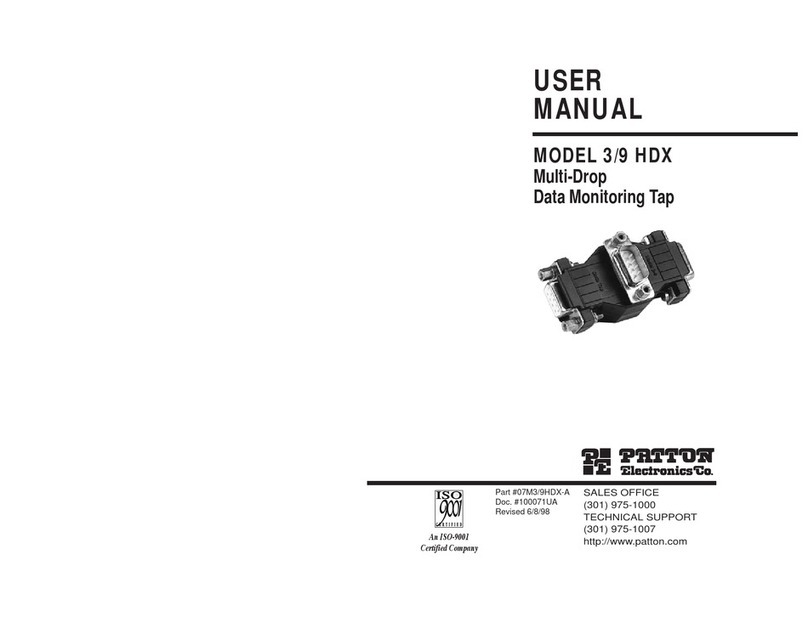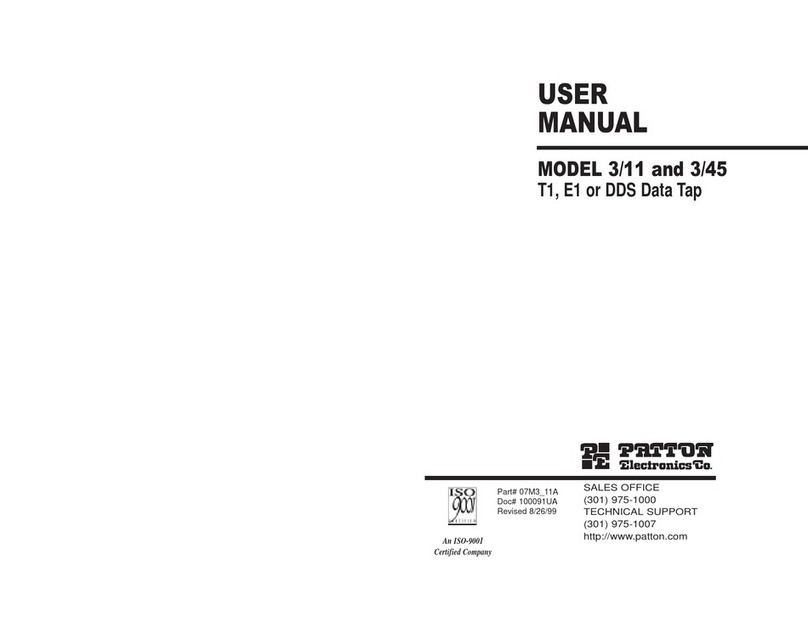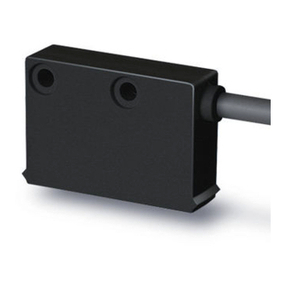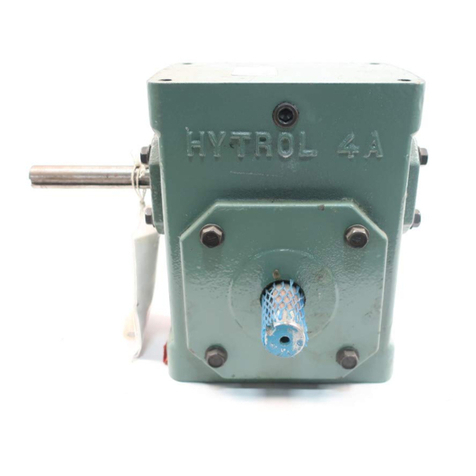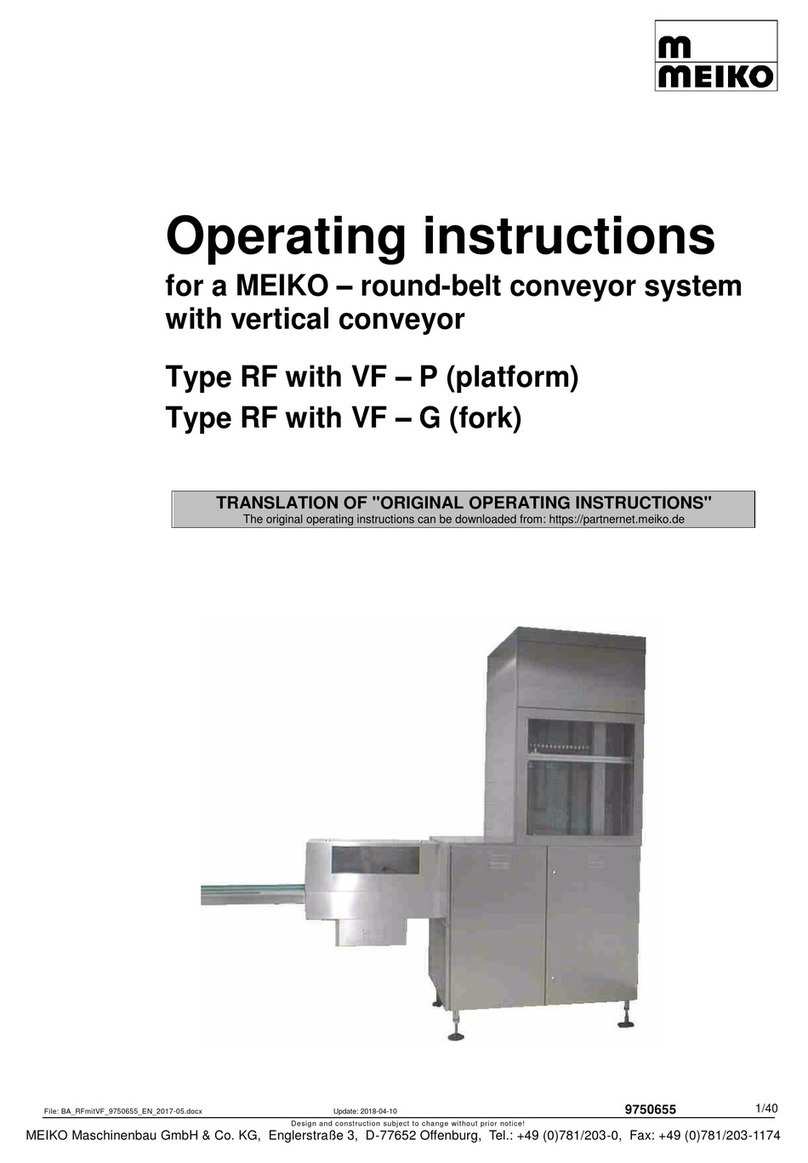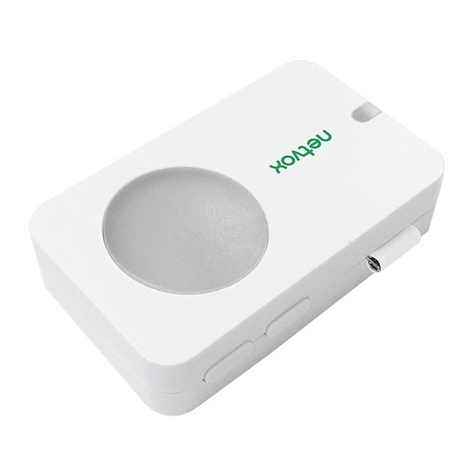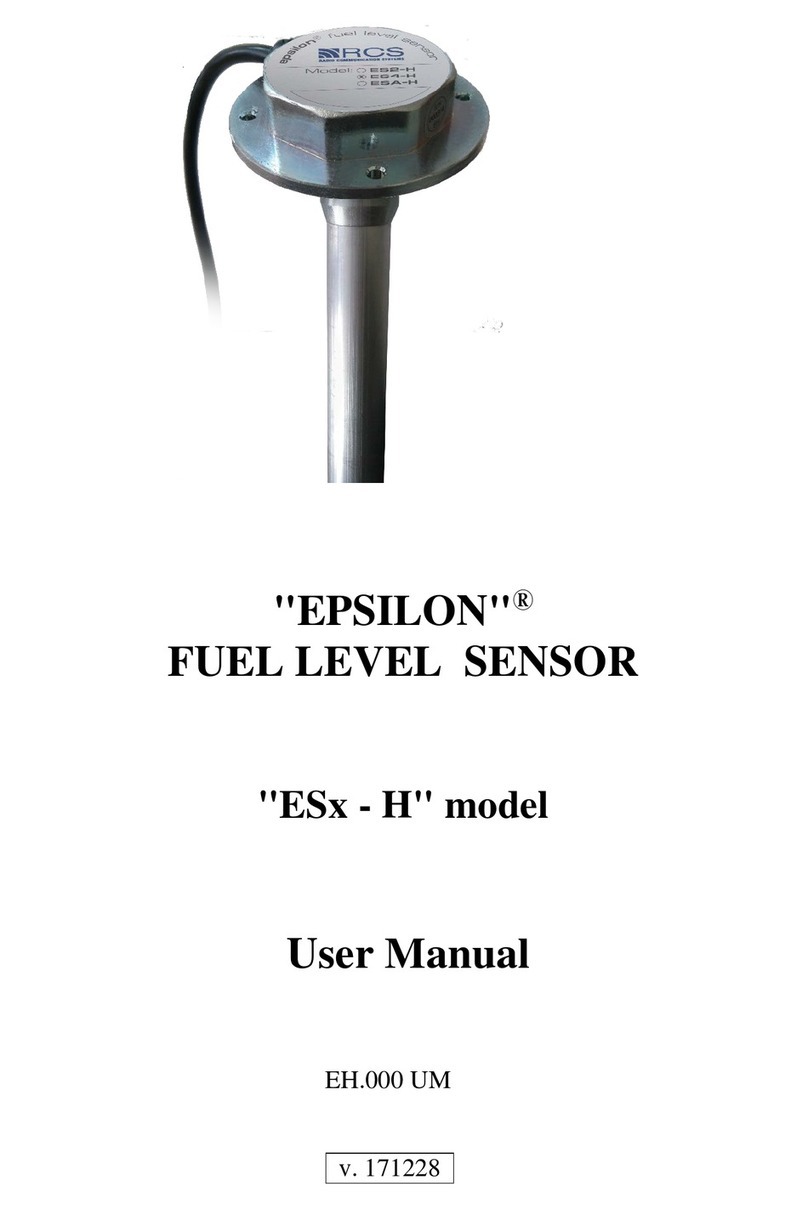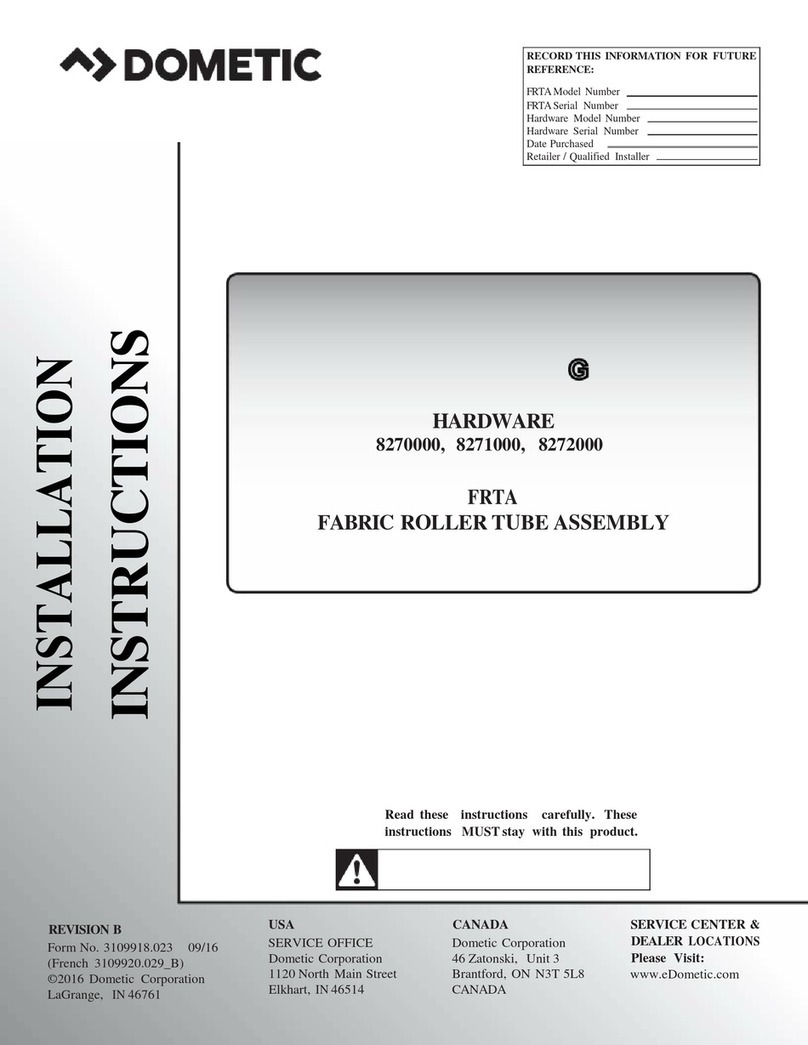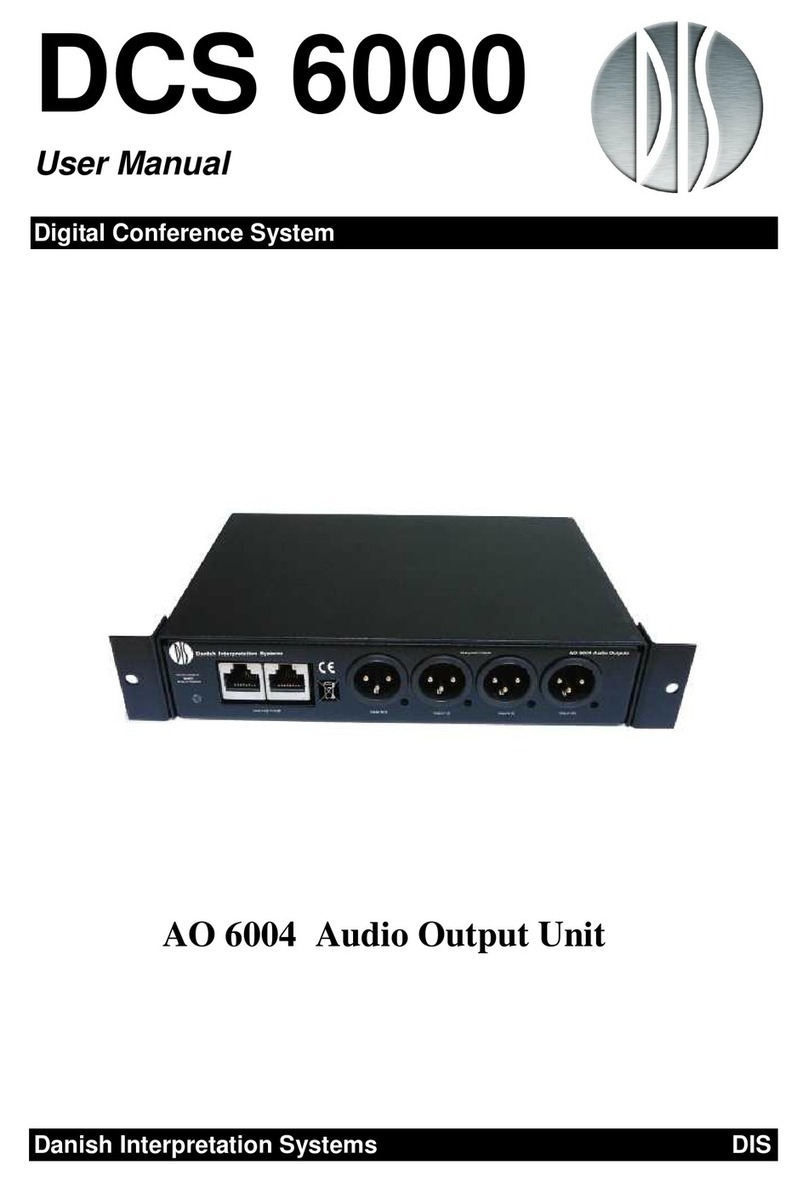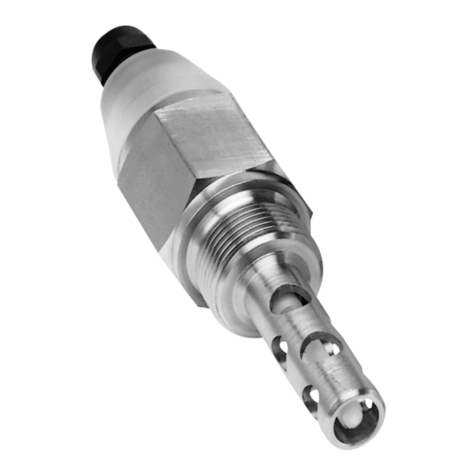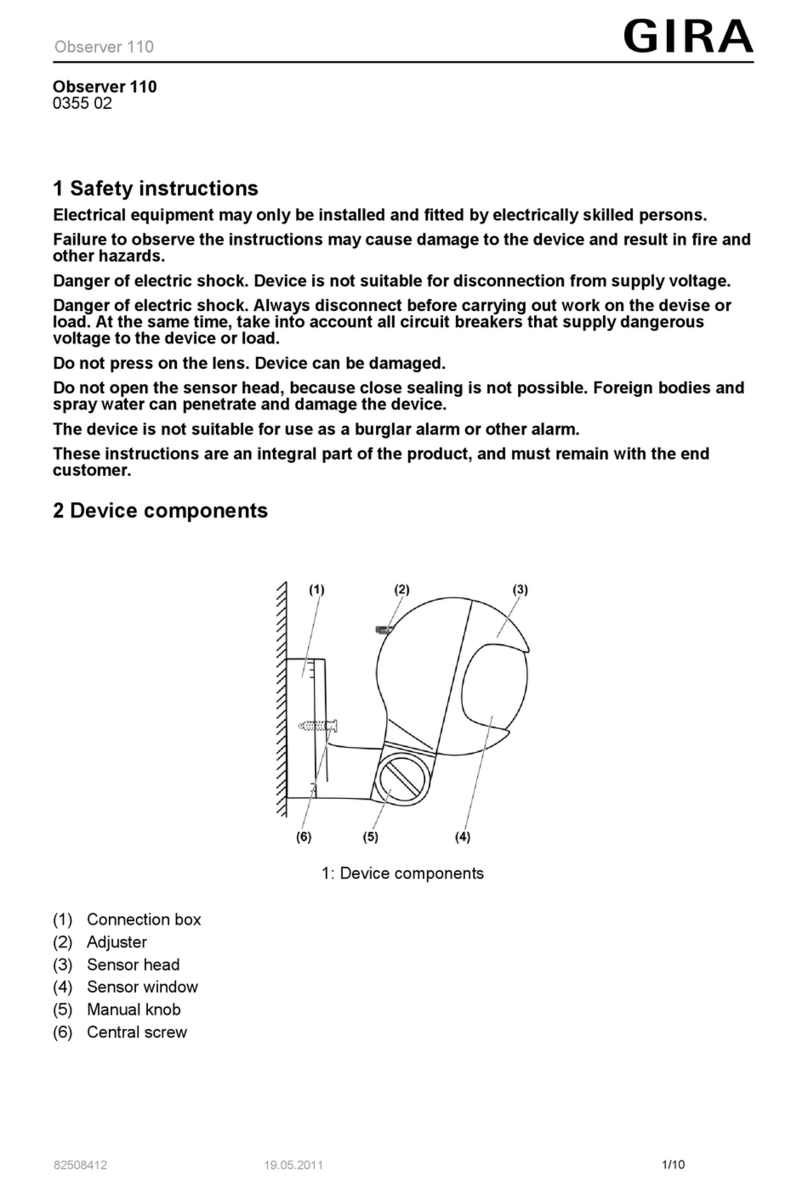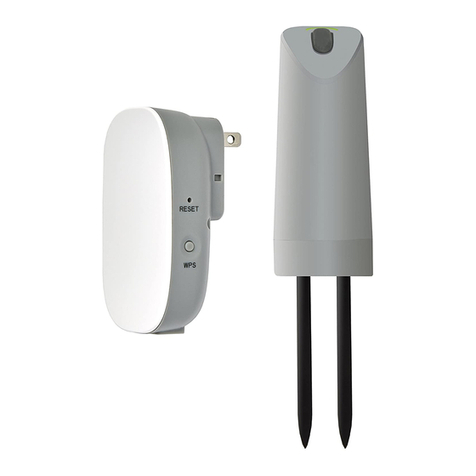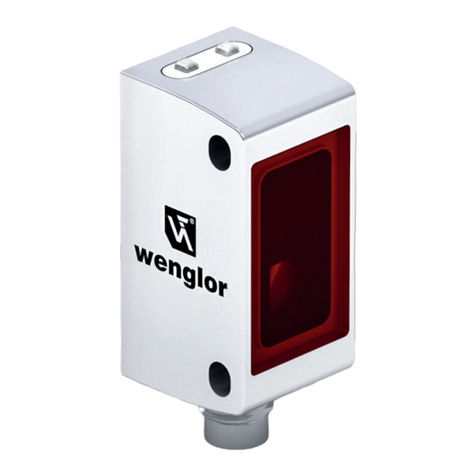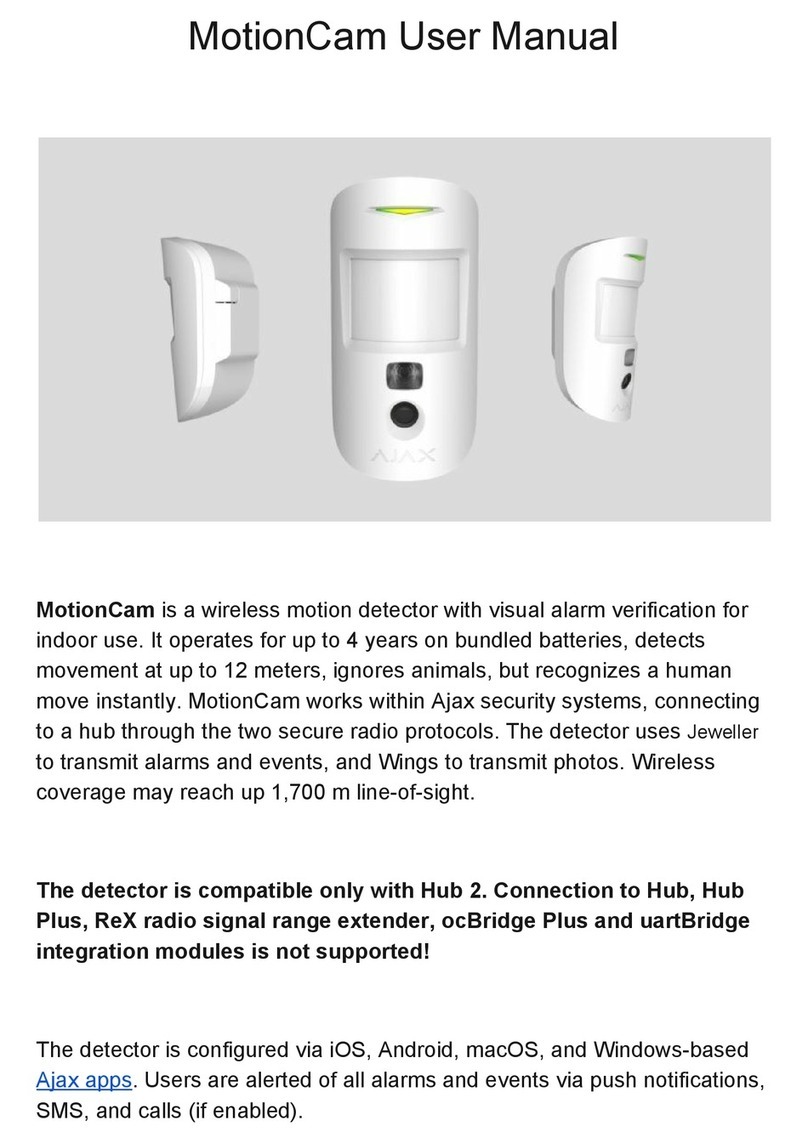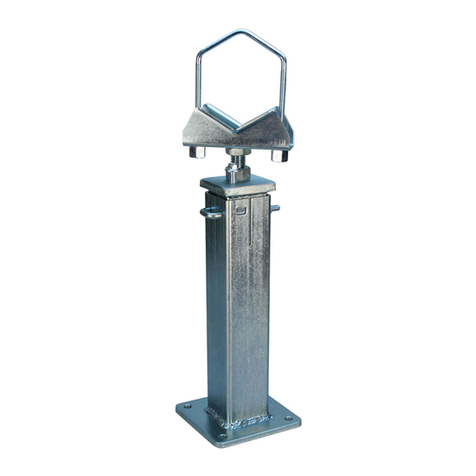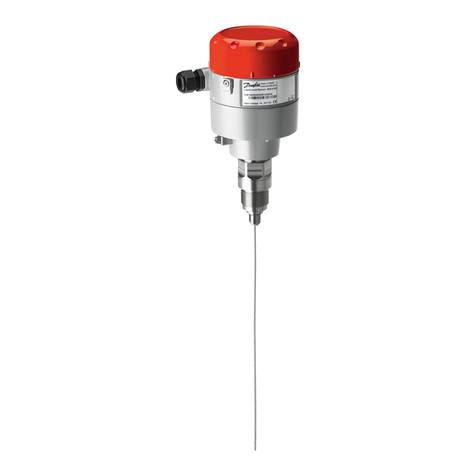Patton electronics 3080/V24 User manual

DIGITAL SHARING DEVICE
3080/V24
(CTS DSD-8)
INSTALLATION AND OPERATIONS MANUAL
Doc #: 124001UA
Part #: 07M3080-A
B
An ISO-9001
Certified Company
Copyright© 2000 Patton Electronics Co., All Rights Reserved
August 23, 2000

3080/V24
124001UA
i
PATTONELECTRONICSCO.INSTALLATION AND OPERATIONS MANUAL
PROPRIETARY NOTICE
The information contained herein is proprietary and confidential to Patton Electronics Co. Any reproduction or
redistribution of this publication, in whole or in part, is expressly prohibited unless written authorization is given by
Patton Electronics Co.
WARRANTY NOTICE
WARRANTIES: Patton Electronics Co. (hereafter referred to as Patton) warrants that its equipment is free from any
defects in materials and workmanship. The warranty period shall be two years from the date of shipment of
equipment. Patton’s sole obligation under its warranty is limited to the repair or replacement of the defective
equipment, provided it is returned to Patton, transportation prepaid, within a reasonable period. This warranty will not
extend to equipment subjected to accident, misuse, alterations or repair not made by Patton or authorized by Patton in
writing.
PUBLICATION NOTICE
This manual has been compiled and checked for accuracy. The information in this manual does not constitute a
warranty of performance. Patton reserves the right to revise this publication and make changes from time to time in the
content thereof. Patton assumes no liability for losses incurred as a result of out-of-date or incorrect information
contained in this manual.
RADIO AND TV INTERFERENCE
The Patton MSDs generate and use radio frequency energy, and if not installed and used properly—that is, in strict
accordance with the manufacturer’s instructions—may cause interference to radio and television reception. The Patton
MSDs have been tested and found to comply with the limits for Class A computing devices in accordance with the
specifications in Subpart J of Part 15 of FCC rules, which are designed to provide reasonable protection from such
interference in a commercial installation. However, there is no guarantee that interference will not occur in a particular
installation. If the Patton MSDs do cause interference to radio or television reception, which can be determined by
disconnecting the cables, the user is encouraged to try to correct the interference by one or more of the following
measures: moving the computing equipment away from the receiver, re-orienting the receiving antenna, and/or
plugging the receiving equipment into a different AC outlet (such that the computing equipment and receiver are on
different branches).
CE NOTICE
The CE symbol on your Patton Electronics equipment indicates that it is in compliance with the electromagnetic
Compatibility (EMC) directive and the Low Voltage Directive (LVD) of the European Union (EU). A Certificate of
Compliance is available by contacting Technical Support.
SERVICE
All warranty and non-warranty repairs must be returned freight prepaid and insured to Patton Electronics. All returns
must have a Return Materials Authorization number on the outside of the shipping container. This number may be
obtained from Patton Electronics Technical Support at:
tel: (301) 975-1007;
email: [email protected];
or, www: http://www.patton.com.
NOTE: Packages received without an RMA number will not be accepted.
Patton Electronics’ technical staff is also available to answer any questions that might arise concerning the installation
or use of your Patton MSDs. Technical Support hours: 8AM to 5PM EST, Monday through Friday.
Copyright© 2000 Patton Electronics Co., All Rights Reserved

3080/V24
124001UA
ii
INSTALLATION AND OPERATIONS MANUAL
PATTON ELECTRONICS CO.
EMISSION REQUIREMENTS
FCC CLASS A
Warning:Changesormodificationstothisunitnotexpresslyapprovedbytheparty
responsiblefor compliance could voidthe user’s authority tooperatethe equipment.
NOTE: This equipment has been tested and found to comply with the limits for a Class A
digital device, pursuant to Part 15 of FCC rules. These limits are designed to provide
reasonableprotection againstharmfulinterference when theequipment is operatedin a
commercialenvironment.Thisequipmentgenerates,uses,andcanradiateradio frequency
energyand,ifnotinstalledandusedin accordancewiththeinstructionmanual, maycause
harmfulinterference toradiocommunications. Operation ofthis equipment ina residential
areaislikelytocause harmful interference in which case the user will be required to correct the
interferenceathisownexpence.
CANADIAN EMISSIONS
This digital apparatus does not exceed the Class A limits for noise emissions from a digital
apparatusset outin theRadio Interference Regulationsof theCanadian Department of
Communications.
Le present appareil numerique n’emet pas de bruits redioelectriques depassant les limites
applicables aux appareils numeriques de la Class A prescites dans le Reglement sur le
brouillage redioelectrique edicte par le ministere des Communications du Canada.
VDE Emissionen
Anhang2 zur Anlage 1 zur AmtsblVfg 243/1991
BescheinigungdesHerstellers/Importeurs
Hiermit wird bescheinigt, daß der/die/das
8 Port Digital Sharing Device, 3080/V24 (CTS DSD-8), 124000
(Gerät,Typ,Bezeichnung)
inÜbereinstimmungmit denBestimmungenderBMPT-AmtsblVfg243/1991 funkentstörtist.
DervorschriftsmäßigeBetrieb mancherGeräte(z.B.Meßsender)kann allerdingsgewissen
Einschränkungenunterliegen. Beachten Sie deshalb die Hinweise in der
Bedienungsanleitung.
DemZentralamtfürZulassungenimFernmeldewesenwurdedasInverkehrbringendieses
Gerätesangezeigtunddie Berechtigungzur Überprüfungder Serieauf dieEinhaltungder
Bestimmungeneingeräumt.
Patton Electronics Co.
7622 Rickenbacker Drive
Gaithersburg, Maryland, USA 20879
(NameundAnschriftdesHerstellers/Importeurs)

3080/V24
124001UA
iii
PATTONELECTRONICSCO.INSTALLATION AND OPERATIONS MANUAL
Table of Contents
CHAPTER 1 - OPERATION
Channel Clocking...............................................................................................................................1-1
Channel Interface .............................................................................................................................. 1-1
Anti-streaming....................................................................................................................................1-2
Channel Selection Modes .................................................................................................................1-3
Channel Tail Circuits .........................................................................................................................1-4
Interface Connections .......................................................................................................................1-4
Front Panel LEDs ..............................................................................................................................1-4
Channel Enable / Disable Switches ..................................................................................................1-4
Power Supply.....................................................................................................................................1-4
CHAPTER 2 - SETUP AND INSTALLATION
Power Connection .............................................................................................................................2-1
Factory Configuration Switch Settings ..............................................................................................2-1
Disassembly ......................................................................................................................................2-2
Installation..........................................................................................................................................2-2
Equipment Grounding (SW27-6).......................................................................................................2-2
CTS Delay (SW31-3,4,5)................................................................................................................... 2-3
Anti-Streaming (SW28-4,5,6 and SW29-3).......................................................................................2-3
Receive Data Mode (SW29-4) ..........................................................................................................2-3
Control Turn-Off Delay in “DATA” Switching Mode (SW29-1,2) ......................................................2-4
Switch on Data / Control (SW29-5,6)................................................................................................2-4
Internal Baud Rates (SW30-1,2,3,4).................................................................................................2-4
Fallback Clock Enable (SW-30-6) ..................................................................................................... 2-5
Fallback Clocking From Sub-Channel 6 (SW30-1,2,3).....................................................................2-5
Fallback Mode Selection (SW30-5)...................................................................................................2-5
TX Clock Source Selection (SW27--1,2,3)........................................................................................2-5
TX Clock Pin Selection (SW27-4) .....................................................................................................2-5
RX Clock Source Selection (SW28-1,2,3) ........................................................................................2-6
Tail Circuit Buffer (SW31-1) ..............................................................................................................2-6
Port DCE/DTE Selection (SW9 thru SW26) .....................................................................................2-7
Test Voltage Enable Pins 9 & 10 (JP4 & JP5)..................................................................................2-7
DTR / DSR Forced Active (JP6 thru JP14).......................................................................................2-8
FACTORY Test Jumpers (JP1, JP2 and JP3)..................................................................................2-8
APPENDIX
Typical Application............................................................................................................................ A-1
Typical Tail Circuit Configuration ..................................................................................................... A-1
Interface Pins Supported.................................................................................................................. A-1
Master DTE / Sub-Channel DTE Interface Flow Diagram............................................................... A-2
Master DTE / Sub-Channel DCE Interface Flow Diagram .............................................................. A-2
Master DCE / Sub-Channel DTE Interface Flow Diagram .............................................................. A-3
Master DCE / Sub-Channel DCE Interface Flow Diagram .............................................................. A-3
TECHNICAL SPECIFICATIONS...................................................................................................... A-4

3080/V24
124001UA
1-1 OPERATION
PATTON ELECTRONICS CO.INSTALLATION AND OPERATIONS MANUAL
CHAPTER 1 - OPERATION
The Patton 3080/V24 (CTS DSD-8) is a network enhancement accessory intended for high
speedsynchronous orasynchronous Modem, orport sharing applications. The3080/V24
(CTS DSD-8) allows for immediate expansion of a system without the requirement of
additional communication lines. The 3080/V24 (CTS DSD-8) allows any combination of up to
eight DCE or DTE devices to share a single DCE or DTE high speed link in a point-to-point or
multi-pointpollednetwork.
Channel Clocking
The Patton 3080/V24 (CTS DSD-8) is protocol transparent and operates in synchronous and
asynchronousenvironmentsat dataratesupto76,800bps, dependingoncablelengthand
attached equipment. Clocking can be derived from the Master Port clock, (pins 15 or 24 for
TXCand 17 for RXC), the internal clock generator or any Sub-Channel 1 through 6(pins 15 or
24 for TXC and 17 for RXC).
Fallback Clocking
IntheeventoflossofanexternallyprovidedclockoroptionallySub-Channel1DCDbecoming
inactive, the 3080/V24 (CTS DSD-8) has the ability to automatically fall back to the
predetermined internal baud rate clock or the Sub-Channel 6 RX Clock (pin 17).
Channel Interface
The 3080/V24 (CTS DSD-8) has nine DB-25 female connectors located on the rear of the unit.
Each connector is pinned with EIA RS-232, using RS-423 electrical characteristics. This
enablesextended cable driving distances,which often bypasses theneedfor line drivers.
Each port is DCE/DTE selectable, which eliminates the need for a crossover cable. DSR or
DTRcanadditionallybeforcedtotheactivestateindividuallyoneachSub-ChannelbyJumper
control.
Pwr SD RD
3080/V24
12345678
SUB-CHANNELSTATUS
FBC 1 2 3 4 5 6 7 8
ANTI-STREAM
1 2 3 4 5 6 7 8
ACTIVE

3080/V24
124001UA
1-2
INSTALLATION AND OPERATIONS MANUAL
OPERATION
PATTON ELECTRONICS CO.
Anti-streaming
A typical problem often encountered is a
“STREAMING”
remote terminal. The streaming
problem can tie up an entire circuit until the offending device has recovered or is powered
down. Astreaming conditionoccurs when aSub-Channel remains active,disrupting the
polling sequence. The 3080/V24 (CTS DSD-8) provides two user selectable modes of
controllinga streamingcondition, an automaticanti-streaming Abort Timerwith eight
selectable block lengths and a setting to disable anti-streaming for large data block transfers,
andamanualOperatorControlmode(frontpanelpushbuttonswitch).
Automatic Anti-streaming
-AutomaticAnti-streamingwill block the asserted control signal
from the Sub-Channel Port, releasing the 3080/V24 (CTS DSD-8) to accept requests from any
otherSub-Channel that has not been locked outdueto a streaming condition. When a Sub-
Channelis locked out for streaming,avisual indication, by Sub-Channel, isprovidedon the
front panel.
Any data sent to the Master Port by the streaming device will be lost, but data
will still be broadcast to locked out Sub-Channels
. Once a Sub-Channel is locked out due to
streaming,theSub-Channelwillremainlockedoutuntiltheattacheddeviceremovesthe
streaming condition. When configured for “Switch on RTS” Mode, if RTS is held active, RTS
mustbecome inactive. When configured for “Switch onData”Mode, if continuous data
transitions have triggered the Anti-Stream logic, the transitions must stop before the DSD-8
willcleartheAnti-StreamlogictothatSub-Channel. RemovingtheSub-Channelviathefront
panel disable switch will not clear the Anti-stream logic for a Sub-Channel once it has been
activated.
Manual Anti-Stream
- If manual Anti-Stream protection is chosen, a streaming condition
caused by one of the attached terminals can be quickly corrected by the 3080/V24 (CTS
DSD-8) via the associated front panel locking switches. A switch is provided for each Sub-
Channelandpermitstherapidremovalofastreamingterminalwithouthavingtodisconnect
anycablesor powerdown theoffending terminal. Terminalsmaybeselectivelyremoved for
self-testandmaintenancewithoutaffectingtheremainingSub-Channels. Oncethestreaming
condition has been corrected, the front panel switch is simply depressed to the locked
(Enable) position (Green indicator ON) to re-establish normal operation. Removing a Sub-
Channelwiththefrontpanelswitchwill blockdatafromtheSub-Channelgoing totheMaster
Portbut will not block data going from the Master Port to theSub-Channel.
Channel Selection Modes
The 3080/V24 (CTS DSD-8) provides two selectable Sub-Channel service modes of
operation, the Scanning Mode and Priority Mode. Depending on system requirements, either
modemaybeselectedby internal DIP switch settings. Both modes switch on activity from the
Sub-Channel.

3080/V24
124001UA
1-3 OPERATION
PATTON ELECTRONICS CO.INSTALLATION AND OPERATIONS MANUAL
In the Scanning Mode the 3080/V24 (CTS DSD-8) scans each Sub-Channel, in sequence,
beginningwithSub-Channel1. Thisrotationalsequenceisrepeatedcontinuallywitheach
attachedSub-Channelhavingequalaccesstothecommunicationslink. Whendataorcontrol
linesfromaSub-Channelbecomeactive thatSub-Channelisswitchedthroughtothemaster
port by the 3080/V24 (CTS DSD-8). All remaining Sub-Channels are locked out until the first
device becomes inactive. When the Sub-Channel device becomes inactive, the 3080/V24
(CTSDSD-8)willresumescanningthe Sub-Channelsforanother activesignal.
When configured for Priority Mode operation, the 3080/V24 (CTS DSD-8) monitors all Sub-
ChannelssimultaneouslywithSub-Channel1havingthehighestpriority. WhenaSub-Channel
becomes inactive, the 3080/V24 (CTS DSD-8) will automatically default to the highest priority
(lowestnumber)Sub-Channelwithactivity.
Contention for the Master port is accomplished by asserting RTS (Request to Send) if the
Sub-Port is configured as a DCE, DCD (Data Carrier Detect) if the Sub-Port is configured as
aDTE or Data Transitions from the attached Sub-Channel devices in either configuration. The
active interface lead RTS or DCD can be selected on an individual basis for each Sub-
channel,selection of contention mode,
“DataTransitions”
or
“InterfaceLead”
activation is
selectedinSub-channelgroups. Sub-channels1thru4 arethefirstgroupandSub-channels 5
thru8 are the second group. All Sub-channels in a group will be settothesame contention
mode, either
“Data Transitions”
or
“Interface Lead”
activation. Once a Sub-Channel asserts
anactivecontrolsignal, thatcontrol signalwill bepassed throughtothe MasterPort,
depending on DTE / DCE configuration of the Sub-Channel and Master Port. This control will
be passed without delays. If the Master Port is configured as a DTE the signal will be passed
as RTS. The CTS returned to the Master will have an optional delay added before the signal is
returnedtotheSub-Channelport.
Port Enable / Disable, front panel switches must be pushed in (GREEN indication) for a Sub-
Channel to access the Master Port regardless of the mode of operation selected.
Channel Tail Circuits
A buffer is built into the unit for tail circuit (DCE to DCE) applications. An 8 bit centered ring
buffer is used to correct the clock phasing errors generated between the Modem on the
MasterPortandtheSub-Channelportforthedatatransferred fromtheSub-Channeltothe
MasterPort. Iftheunitisoperatedinanasynchronousenvironmentthebuffermustbe
bypassed. This is accomplished by moving the SYNC/ASYNC switch to ASYNC.

3080/V24
124001UA
1-4
INSTALLATION AND OPERATIONS MANUAL
OPERATION
PATTON ELECTRONICS CO.
Interface Connections
All connections are made via industry standard EIA RS-232 DB-25 female connectors located
ontherearofthe unit. The following interface leads are implemented, Chassis (1), TXD (2),
RXD (3), RTS (4), CTS (5), DSR (6), Sig Gnd (7), DCD (8), Plus Unreg (9), Minus Unreg (10),
TXC (15), RXC (17), DTR (20), XTXC (24). Pins 9 & 10 can be disabled by Jumpers on the
PCB.
Front Panel LEDs
Front panel LEDs are provided to indicate power is applied, RXD and TXD activity from the
MasterPort, Sub-Channel activityof each individual Port,Anti-Stream condition of eachSub-
Channeland an indication of clockfallbackcondition.
Channel Enable / Disable Switches
FrontpanelswitchesallowoperatorinterventiontoremoveanindividualSub-Channelfrom
accessing the Master Port. Positive latching type switches are provided for each Sub-
Channelport for isolating orremoving a streaming terminal. TheSub-Channelis activated by
pushingthe switch until it isinthe “IN”position. Theswitch will indicateGREEN incolor. To
disablea Sub-Channel push the switch until it locks in the “OUT” position, the switch will
indicate BLACK in color. Disabling a Sub-Channel with the front panel does not prevent the
Sub-Channelfrom receiving data fromthe Master Port onlyfromsending data to theMaster
Port.
Power Supply
Alinear power supply is located internally, an external 110/220VA switch is located on therear
of the unit. If chassis ground and signal ground need to be tied together this can also be
accomplished by switch selection. The unit is Rackmountable for 19" (or optional 23")
cabinets, by using the included Rackmount Kit. Safety approvals granted are UL, CSA and
TÜV. Emission approvals for FCC Class A and VFG243 have also been granted.

3080/V24
124001UA
2-1 SETUP & INSTALLATION
PATTON ELECTRONICS CO.INSTALLATION AND OPERATIONS MANUAL
Caution,DisconnectthePOWERBeforeRemovingTheCover
Vorsicht,BeforDeckungAbnehmenMachStromZu.
CHAPTER 2 - SETUP AND INSTALLATION
Power Connection
Before connecting the 3080/V24 (CTS DSD-8) to a AC power source the top cover must be
installed and secured with the supplied #8-32 screws. The unit is supplied with a 110/220VA
voltageswitch,turnthe switchwith acoin orscrew drivertothe appropriatevoltage foryour
country. Iftheunitissetto110Vinsurethat
the fuses are 0.16A Slow Blow (Little Fuse
218.160). For 220V operation use 0.08A
(Little Fuse 218.080) Slow Blow fuses.
EXAMPLE: United States of America; set
to 110VA. The unit is supplied with a IEC
powerconnectornexttothevoltageselect
switch,plugthepowercordintothe
connectoruntilitisfirmlyseated. You
maynowconnect thepower cordinto
yourACoutlet.
Factory Configuration Switch Settings
The 3080/V24 (CTS DSD-8) is configured prior to shipment with the switches set to the
followingdefaultpositions:
Switch 27 - 6 OFF, 1,2,3,4 and 5 ON.
TX Clock Source = Master, pin 15
ChassisGroundnotconnected toSignalGround
Switch 28 - 4 and 5 OFF, 1,2,3 and 6 ON.
RX Clock Source = Master
Anti-Stream timer = 16K bits
Switch 29 - 1, 2 and 4 to OFF, 3,5 and 6 ON.
No Data Time Out = 2048 bits
Anti-Stream = Enabled
Broadcast Data to Sub-Channels
Sub-ChannelActivityIndicatedbyInterfaceControl(RTS/DCD)
110 / 220VA Switch
Fuse Drawer
MASTER DTE/ DCE
IEC Power Connector
110
220

3080/V24
124001UA
2-2
INSTALLATION AND OPERATIONS MANUAL
SETUP & INSTALLATION
PATTON ELECTRONICS CO.
Switch 30 - 1 and 2 OFF, 3, 4, 5 and 6 ON
InternalBaudRate=9600,Normal
Fallback Clock Source = Data Transitions
Fallback Clock = Disabled
Switch 31 - 2 and 3 to OFF, 1,4,5 and 6 to ON
SyncMode
Contention Mode = Scan
CTS Delay = 1 mS
If the system application requires one or more of the default settings to be changed, it will be
necessaryto remove the top cover of the enclosure to access and changetheDIPswitches
located on the printed circuit board.
Disassembly
Remove the top cover by removing the phillips head screws located on the left and right sides
of the 3080/V24 (CTS DSD-8). DTE/DCE switches SW9 through SW26, interface Jumpers
J4 through J14 and configuration switches SW27 through SW31 are located on the PCB as
indicated on the strapping guide in the Appendix of this manual. After the switch selection
activity is completed,
re-install the top cover BEFORE connecting to a AC power source
.
Installation
Select an appropriate location accessible to and within six feet of an AC power outlet, the
outletmusthavea groundpin receptaclefor productwarranty. The DCE-to-DTEcabling
between each attached device and the 3080/V24 (CTS DSD-8) should be “Straight Through”,
shieldedandterminated withmale connectors. Sub-Channelsare markedPORT1through
PORT 8, the Master Port is marked, MASTER DCE/DTE. If any terminal has a priority service
mode, ensure it is connected to the port connector designated “PORT 1” on the rear panel of
the 3080/V24 (CTS DSD-8). Secure other terminals or Modems to be serviced to the
remaining“PORT”connectors. ConnecttheMODEMorTERMINALtotheconnector
designated “MASTER DTE/DCE”.
Equipment Grounding (SW27-6)
(default OFF)
SwitchSW27-6 provides for grounding interconnection in those systems requiring a
connectionbetween(FrameGround)and(SignalGround). ConnectONLYifrequired.

3080/V24
124001UA
2-3 SETUP & INSTALLATION
PATTON ELECTRONICS CO.INSTALLATION AND OPERATIONS MANUAL
CTS Delay (SW31-3,4,5)
If a CTS delay is desired, set SW31-3, 4 and 5 to the required value as indicated below.
SW31-3 SW31-4 SW31-5 Time
ON ON ON No Delay
OFF ON ON 1mS
ON OFF ON 2mS
OFF OFF ON 4mS
ON ON OFF 9mS
OFF ON OFF 18mS
ON OFF OFF 36mS
OFF OFF OFF 72mS
Anti-Streaming (SW28-4,5,6 and SW29-3)
The maximum data block size is user selectable via switch SW28- 4, 5 and 6. As shown
below eight block sizes are provided to the user. To disable anti-streaming set SW29-3 to the
OFF position. The maximum block size is normally defined at the time of installation.
SW28-4 SW28-5 SW28-6 CLOCKS
ON ON ON 1024
OFF ON ON 2048
ON OFF ON 4096
OFF OFF ON 16K
ON ON OFF 64K
OFF ON OFF 256K
ON OFF OFF 1 MEG
OFF OFF OFF 2MEG
Receive Data Mode (SW29-4)
(default OFF)
Setting switch SW29-4 to ON sets the DSD-8 into the Gated Mode. Only the Sub-Channel that
is currently active will receive the data from the master port. Setting position 4 toOFF enables
the Broadcast mode. Receive Data from the Master Port is sent to all Sub-Channels.

3080/V24
124001UA
2-4
INSTALLATION AND OPERATIONS MANUAL
SETUP & INSTALLATION
PATTON ELECTRONICS CO.
Control Turn-Off Delay in “DATA” Switching Mode (SW29-1,2)
When configured to switch on DATA, switch SW29-1 and 2 set the Sub-Channel release time
inclocks. The valueselected isthe number ofclocks atthe current baudrate thatmust occur
withoutanydatatransitionsontheSub-ChanneltoindicatethatSub-Channelhascompleted
its transmission and the 3080/V24 (CTS DSD-8) can resume servicing the other Sub-
Channels. Thefollowingtableshouldbe used to set this time period.
SW29-1 SW29-2 CLOCKS
ON ON 16
ON OFF 64
OFF ON 256
OFF OFF 2048
Switch on Data / Control (SW29-5,6)
(default 5-ON, 6-ON)
Sub-channelsare selectable for switch on DATA or switch on an active interfacecontrollead
in groups of 4 Sub-Channels. Set SW29 pos 5 to OFF if you want Sub-channels 1 thru 4 set to
switch on
"Data Transitions"
. Set pos 5 to ON if you want them to be set to switch on
"Interface Lead". SW29 pos 6 is associated with sub-channels 5 thru 8.
Internal Baud Rates (SW30-1,2,3,4)
Switch SW30-1, 2, 3 and 4 select the master clock rate when Internal Clock Source is selected
on TX Clock Source or RX Clock Source. In addition the fallback clock rate is also selected
with this option. When fallback clocking is required, the RX Clock Source and TX Clock
Source should NOT be set to INTERNAL. Selecting CHAN 6 RXC allows fallback clocks to
originatefrom Sub-Channel 6 pin 17. The following table shows the available rates. If CHAN
6 RXC is selected, SW30-4 can be in either position.
SW30-1 SW30-2 SW30-3 Pos 4=ON Pos4=OFF
ON ON ON 76,800 57,600
OFF ON ON 38,400 28,800
ON OFF ON 19,200 14,400
OFF OFF ON 9,600 7,200
ON ON OFF 4,800 3,600
OFF ON OFF 2,400 1,800
ON OFF OFF 1,200 900
OFF OFF OFF CHAN 6 RXC

3080/V24
124001UA
2-5 SETUP & INSTALLATION
PATTON ELECTRONICS CO.INSTALLATION AND OPERATIONS MANUAL
Fallback Clock Enable (SW-30-6)
(default ON)
If Clock Fallback is required when the primary clock fails, set switch SW30-6 to OFF. If
Fallback is not required set SW30-6 to ON. The Fallback clock rate is selected with the
internal baud rate option. When enabled, the Front Panel FBC LED will light if clock Fallback
occurs.
Fallback Clocking From Sub-Channel 6 (SW30-1,2,3)
To use the Sub-Channel 6 RX Clock as the fallback clock set SW30-1, 2 and 3 to OFF. Any
otherposition will selectsome internal clock rateas called out inthe Internal BaudRates
section.
Only Sub-channel 6 can be used as the fallback clock
.
Fallback Mode Selection (SW30-5)
(default ON)
If Fallback is required, two modes are available via switch SW30-5. To fallback when the
transitions from the primary clock source stop, set SW30-5 to ON. To fallback when DCD on
Sub-Channel 1 becomes inactive, set SW30-5 to OFF.
NOTE:BothTXandRXClockSourceSelectMUSTBeSet!!!!
TX Clock Source Selection (SW27--1,2,3)
TX Clock Source is selected by switch SW27-1, 2 and 3. The following table indicates the
source options provided by the 3080/V24 (CTS DSD-8).
SW27-1 SW27-2 SW27-3 Source
ON ON ON Master
OFF ON ON Port 1
ON OFF ON Port 2
OFF OFF ON Port 3
ON ON OFF Port 4
OFF ON OFF Port5
ON OFF OFF Port 6
OFF OFF OFF Internal
TX Clock Pin Selection (SW27-4)
(default ON)
The primary transmit clock can be derived from either pin 15 or 24. If pin 15 is to be the
source for primary TX Clock, set SW27-4 to ON. If pin 24 is to be the source for primary TX
and RX Clock, set SW27-4 to OFF.

3080/V24
124001UA
2-6
INSTALLATION AND OPERATIONS MANUAL
SETUP & INSTALLATION
PATTON ELECTRONICS CO.
RX Clock Source Selection (SW28-1,2,3)
RX Clock Source is selected by SW28-1, 2 and 3. The following table indicates the source
options provided by the 3080/V24 (CTS DSD-8). NOTE: If TXC Source is pin 24 That clock
will be used as the RXC also.
SW28-1 SW28-2 SW28-3 Source
ON ON ON Master
OFF ON ON Port 1
ON OFF ON Port 2
OFF OFF ON Port 3
ON ON OFF Port 4
OFF ON OFF Port5
ON OFF OFF Port 6
OFF OFF OFF Internal
Tail Circuit Buffer (SW31-1)
(default ON)
The 3080/V24 (CTS DSD-8) has a Tail Circuit Buffer that is automatically selected when a
Sub-Channelis set as a DTE. Thebufferwill provide clock synchronization ofthedata from
theSub-Channel to the MasterPort for Tail Circuitoperations. Thebuffer is de-activated when
theSub-Channelisconfigured asaDCE. When operatinginanasynchronousenvironment
theBuffermustbebypassed. Tobypassthebufferinasynchronousorasynchronous
application, set switch SW31-1 to OFF (ASYNC). For normal operation in a synchronous
environment set SW31-1 to ON (SYNC). When using a tail circuit modem with the 3080/V24
(CTSDSD-8), themodem connectedto the Sub-Channel,should beset to ExternalTransmit
Clocking. The modem at the remote end of the connection should be set to RX-TX Clocking
orSlaved TX Clock. Thiswill insure the sameclock is present throughoutthe network and
clock slippage will not occur.

3080/V24
124001UA
2-7 SETUP & INSTALLATION
PATTON ELECTRONICS CO.INSTALLATION AND OPERATIONS MANUAL
Port DCE/DTE Selection (SW9 thru SW26)
Slide switches SW9 through SW26 are used to configure DTE/DCE for each port. Slide Both
switches associated with a port to the same position.
Example:
If connecting a modem (DCE
Device) to the PORT, then the port should be configured as a DTE interface. Slide both
switchesto the DTE positiontoward the interface connector. Ifconnectinga terminal (DTE) to
the Sub-Channel, the port should be configured as a DCE. Slide both switched to the DCE
position away from the interface connector.
The port is always configured opposite to the
interface that is to be connected to it
. When a port is selected as a DCE, pin 9 and 10 test
voltages are provided to the interface connector if JP4 and JP5 are installed. If the port is
configured as a DTE, pins 9 and 10 are open. JP4 and JP5 control Plus Unreg and Minus
Unreg to all Sub-Channels, therefore it is not possible to have test power on one DCE without
havingiton allDCESub-Channels.
Test Voltage Enable Pins 9 & 10 (JP4 & JP5)
Pin 9 and Pin 10 unregulated power is provided on each DB-25 connector configured as a
DCE if JP4 and JP5 are installed. Pin 9 and 10 unregulated power is not provided to any
connector configured as a DTE regardless of JP4 and JP5 installation.

3080/V24
124001UA
2-8
INSTALLATION AND OPERATIONS MANUAL
SETUP & INSTALLATION
PATTON ELECTRONICS CO.
DTR / DSR Forced Active (JP6 thru JP14)
DTR is tied to DSR on each of the Sub-Channel ports. If the device connected does not
supply a DTR but requires DSR (DTE) or does not supply DSR but requires DTR (DCE),
installingthe forcedDTR/DSR jumper(JP6-JP14) for theappropriate Sub-Channelwill solve
this problem. The line is forced to +6V via an 100Ωresistor, providing isolation to any driver
thatmightbeontheinterface.
Channel Jumper Channel Jumper
Master JP6 5JP11
1JP7 6JP12
2JP8 7JP13
3JP9 8JP14
4JP10
FACTORY Test Jumpers (JP1, JP2 and JP3)
ThethreefactorytestjumpersJP1,2and3,must beinstalledfortheunit toproperlyfunction.
Thesejumpersare usedin themanufacture andtestoftheproduct priorto shipment.

3080/V24
124001UA
A-1 APPENDIX
PATTON ELECTRONICS CO.INSTALLATION AND OPERATIONS MANUAL
APPENDIX
Interface Pins Supported
Typical Tail Circuit Configuration
Typical Application
DB-25 RS-232
1
2
3
4
5
6
7
8
9
10
11
12
13
14
15
16
17
18
19
20
21
22
23
24
25
Shield (common)
Transmit Data (from DTE)
Receive Data (from DCE)
Request to Send (from DTE)
Clear To Send (from DCE)
Data Set Ready (from DCE)
Si
g
nal Ground (common)
Data Carrier Detect (from DCE)
+ Volta
g
e
- Volta
g
e
Transmit Clock (from DCE)
Receive Clock (from DCE)
Data Terminal Ready (from DTE)
External Transmit Clock (from DTE)
3080/V24
RS-423
Leased
or
Dial Line
Leased
or
Dial Line
Leased
or
Dial Line
RS-423 MODEM
RS-423 MODEM
RS-423 MODEM
3080/V24
RS-423 RS-423
RS-423 RS-423
RS-423
Host
TXC-15
RXC-17
Modem
Modem
3080/V24
XTXC-24
RXC-17
RXC-17
TXC-15
RXC-17TXC-15
Terminal
Buffer
External
TX Clocking
Slave
TX Clocking
Modem
XTXC-24
Slave
TX Clocking
XTXC-24 Data
Internal
TX Clocking
Data
Data
Data Data Data
Data
Modem

3080/V24
124001UA
A-2
APPENDIX
INSTALLATION AND OPERATIONS MANUALPATTON ELECTRONICS CO.
Master DTE / Sub-Channel DCE Interface Flow Diagram
Master DTE / Sub-Channel DTE Interface Flow Diagram
Master Port is a DTE
Pin 3 RXD Pin 2 TXD
Pin 2 TXD Pin 3 RXD
Pin 4 RTS
Pin 5 CTS
Pin 6 DSR
Pin 8 DCD
Pin 20 DTR
Pin 4 RTS
Pin 5 CTS
Pin 6 DSR
Pin 8 DCD
Pin 20 DTR
Switch Control
Buffer
+6v
Pin 15 TXC
Pin 17 RXC
Pin 24 ETXC
Pin 15 TXC
Pin 17 RXC
Pin 24 ETXC
Clk InClk Out
Master RX Clock
Selection Logic
Master TX Clock
Selection Logic
Channel Port is a DTE
Pin 15 TXC
Pin 17 RXC
Pin 24 ETXC
Pin 15 TXC
Pin 17 RXC
Pin 24 ETXC
Master RX Clock
Selection Logic
Master TX Clock
Selection Logic
Master Por t i s a DT E
Pin 3 RXD Pi n 3 RXD
Pin 2 TXD Pin 2 TXD
Pin 4 RTS
Pin 5 CTS
Pin 6 DSR
Pin 8 DCD
Pi n 20 DTR
Pin 4 RTS
Pin 5 CTS
Pin 6 DSR
Pin 8 DCD
Pin 20 DTR
Switch Control
Channel Port is a DCE

3080/V24
124001UA
A-3 APPENDIX
PATTON ELECTRONICS CO.INSTALLATION AND OPERATIONS MANUAL
Master DCE / Sub-Channel DCE Interface Flow Diagram
Master DCE / Sub-Channel DTE Interface Flow Diagram
Pin 15 TXC
Pin 17 RXC
Pin 24 ETXC
Pin 15 TXC
Pin 17 RXC
Pin 24 ETXC
Master RX Clock
Selection Logic
Master TX Clock
Selection Logic
Pin 20 DTR Pin 20 DTR
Master Port is a DCE
Pin 2 TXD Pin 3 RXD
Pin 3 RXD Pin 2 TXD
Pin 4 RTS
Pin 5 CTS
Pin 6 DSR
Pin 8 DCD
Pin 4 RTS
Pin 5 CTS
Pin 6 DSR
Pin 8 DCD
Switch Control
+6v
Channel Port is a DCE
+6v
Clk InClk Out
Pin 15 TXC
Pin 17 RXC
Pin 24 ETXC
Pin 15 TXC
Pin 17 RXC
Pin 24 ETXC
Master RX Clock
Selection Logic
Master TX Clock
Selection Logic
Pin 20 DTR Pin 20 DTR
Master Port is a DCE
Pin 2 TXD Pin 2 TXD
Pin 3 RXD Pin 3 RXD
Pi n 4 RTS
Pin 5 CTS
Pin 6 DSR
Pin 8 DCD
Pin 4 RTS
Pin 5 CTS
Pin 6 DSR
Pin 8 DCD
+6v
Switch Control
Channel Port is a DTE
+6v
Buffer
1

3080/V24
124001UA
A-4
APPENDIX
INSTALLATION AND OPERATIONS MANUALPATTON ELECTRONICS CO.
TECHNICAL SPECIFICATIONS
Applications
Multiple Sync or Async DCE or DTE devices
sharing one DCE or DTE link
Capacity
One to Eight Sync or Async DTE or DCE
devices One DCE or DTE Master Channel
Data Format
Data transparent at all data rates
Data Rates
Up to 76,800bps
Timing
Internal: .......DIP switch selectable
Normal: ....... From Modem
External:...... Clock provided on Sub-Channels
1-6
Anti-streaming
Automatic:Selectable timeout intervals or
disable
Terminal Service Modes
Scanning Mode: .......Channels are continuously
scanned for activity on a
sequential basis.
PriorityMode: ...........Channels are
simultaniously monitored
channel one has highest
access
Sub-Channel Interface
EIA RS-232 female connectors (DB-25) using
RS-423 electrical characteristics.
Modem Interface
EIA RS-232 female connector (DB-25) using RS-
423 electrical characteristics.
Front Panel
Indicators: ..... Power, Send/Receive Data, Clock
Fallback, Sub-Channel Active,
Sub-Channel Stream
Switches: ...... Enable/Disable each Sub-Channel
Power Source
100-120/200-240 Vac, 50 to 60 Hz, 0.16/0.08 A,
Switch Selectable, 7 Watts
Certifications
MET, c-MET, CE
Dimensions
Height: ...... 1.75 inches (4.44 cm)
Width:....... 17.00 inches (43.18 cm)
Length: .....11.00 inches (18.93 cm)
Weight
4.5 lbs (2.1 Kg)
Table of contents
Other Patton electronics Accessories manuals

